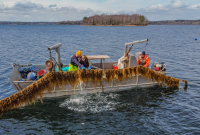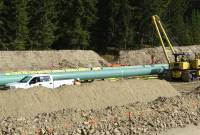Support strong Canadian climate journalism for 2025
Energy giant Suncor has moved into the next phase of its plans to expand oil and gas drilling off the coast of Newfoundland and Labrador, bolstering the province’s push to become an offshore superpower.
Public comment opened for the company’s Tilt Cove exploration drilling project on Monday as part of the federal impact assessment process. According to Suncor, the project would include drilling 12 to 16 wells about 300 kilometres off the coast of St. John’s. If approved, the company would have nine years to find oil and gas reserves.
Suncor is envisioning fossil fuel extraction well past 2030, the deadline for Canada’s pledge to reduce planet-warming greenhouse gas emissions by 40 to 45 per cent from 2005 levels. That commitment falls under the Paris Agreement, which aims to keep global temperatures no higher than 1.5 C above pre-industrial levels. However, the United Nations weather agency said this week that the world is more likely than not to temporarily reach that level of warming in the next five years, bringing more extreme heat waves, droughts and storms that will displace and kill people and harm biodiversity.

According to the UN, fossil fuels are easily the largest contributor to global warming, making up 75 per cent of greenhouse gas emissions and 90 per cent of carbon emissions.
The continued push for oil and gas extraction leaves Gretchen Fitzgerald speechless. The Sierra Club Canada Foundation national program director says it goes against international, national and provincial climate targets. She notes Newfoundland and Labrador is already not on track to meet its climate goals, and questions how the project could fit into the federal government’s pending cap on oil and gas emissions from the fossil fuel industry.
“The climate impacts of what they're doing and the ocean impacts of what they're doing are reprehensible and should not be approved,” she said.
Canada’s National Observer reached out to Suncor for comment but did not receive a response in time for publication.
In April 2022, Equinor’s Bay du Nord project was approved by the federal government. The Sierra Club, along with Equiterre and Mi'gmawe'l Tplu'taqnn Incorporated — a group representing eight Mi’gmaq communities in New Brunswick — went to court in March to challenge the approval and are awaiting a decision.
Newfoundland and Labrador sees Bay du Nord as the start of a boom for its offshore industry. It’s inviting the world’s oil majors to further explore the area off its coast in hopes more production will aid the economically struggling province’s balance sheet — all part of a plan to double offshore oil production by the end of the decade.
“There needs to be a pathway for Newfoundland and Labrador. The demand for what they're drilling for is going down and down and down,” said Fitzgerald.
“... But doing it for a project that cannot reach its end goal is beyond reckless.”
In Suncor’s draft Environmental Impact Statement (EIS), a mandatory overview done by companies outlining how their project could impact local ecosystems, the company says it could start drilling as early as 2024 if federal approval is granted. According to its project description, Suncor is conducting the drilling on behalf of its partners, Equinor and Husky, which has since been acquired by Cenovus.
In the draft EIS, the company notes 32 species of marine mammals could be present in the project area along with six species of seals and four turtle species. Depending on ocean depth, a temporary barge, rig or ship goes out and drills into the ocean floor to pump oil up from the deposit. Many of the same concerns critics have for marine life during oil production overlap with their worries during exploratory activity.
The 2010 BP Deepwater Horizon spill, the largest in U.S. history, came from an exploratory well. According to the Center for Biological Diversity, the spill, which killed 11 people, “likely harmed or killed about 82,000 birds of 102 species; about 6,165 sea turtles; as many as 25,900 marine mammals; and a vast (but unknown) number of fish — from the great bluefin tuna to our nation's smallest seahorse — plus oysters, crabs, corals and other creatures.”
“Exploration drilling is one of the riskiest phases … we're putting endangered whales, seabirds, fish, at risk ... for oil that cannot come out of the ground, if you want a safe future,” said Fitzgerald.






Comments